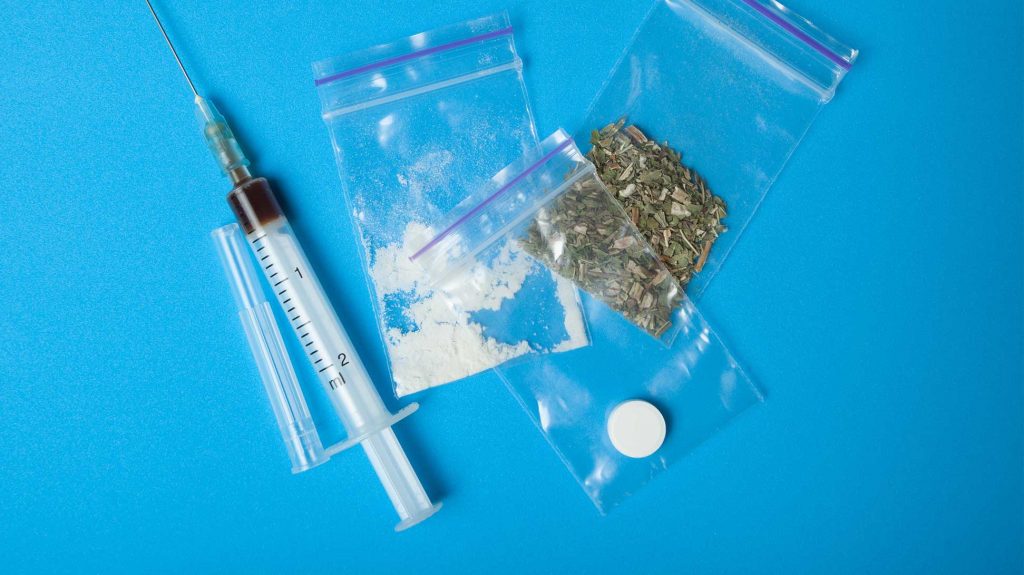Some substances with a high abuse potential still have medical uses. These substances include:
- opioids like fentanyl, oxycodone (OxyContin), and oxymorphone (Opana)
- benzodiazepines like alprazolam (Xanax), lorazepam (Ativan), and diazepam (Valium)
- stimulants like amphetamine (Adderall), methylphenidate (Ritalin), and even methamphetamine (Desoxyn)
However, other drugs of abuse are never used medically. The United States Drug Enforcement Administration (DEA) classifies these substances as Schedule I drugs under the Controlled Substances Act (CSA). Here are ten.
1. Heroin
Heroin is a semi-synthetic opioid analgesic (painkiller) made from morphine (a natural opioid found in the opium poppy plant). It appears as a white or brown powder or a black goo. It’s usually injected, snorted, or smoked.
No matter how it’s used, heroin causes a rush of relaxation and euphoria (intense joy). It can also cause physical dependence, which means your body can’t function normally without the drug.
Heroin is the only opioid without accepted medical use. The DEA categorizes other opioids into other drug schedules.
For example, methadone, hydromorphone (Dilaudid), hydrocodone (Vicodin), and meperidine (Demerol) belong to Schedule II, tramadol (Ultram) belongs to Schedule IV, and products with codeine belong to Schedule III or Schedule V (depending on how much codeine the product contains).
2. Khat
Khat is a plant native to East Africa and southern Arabia. Its main psychoactive ingredients are cathine and cathinone. When eaten or smoked, khat causes stimulant effects such as increased alertness and euphoria.
The drug can also have more serious effects, including:
- paranoia (extreme mistrust of others)
- delusions (beliefs that aren’t based in reality)
- hallucinations (seeing, hearing, or feeling things that aren’t there)
- insomnia (trouble sleeping)
- depression and suicidal thoughts
- heart problems
3. Synthetic Cathinones
Also called “bath salts,” synthetic cathinones are human-made stimulants. They’re chemically related to khat. However, they’re much more potent.
The drugs likely resemble a white or brown powder. They can have serious effects, including:
- paranoia
- delusions
- hallucinations
- panic attacks
- agitation
- violent behavior
- seizures
- heart attack or stroke
These drugs are highly addictive and have no approved use in medicine.
4. GHB
GHB (gamma-hydroxybutyric acid) is a central nervous system (CNS) depressant. That means it slows down brain activity. It typically appears as a white powder or clear liquid.
Potential effects of GHB include:
- euphoria
- decreased anxiety
- drowsiness
- confusion
- impaired memory
- aggression
The drug can also cause physical dependence and addiction.
5. LSD
As a hallucinogen, LSD (lysergic acid diethylamide) changes your perceptions, mood, and thinking. It’s a clear or white material made from lysergic acid, a substance found in a fungus that grows on grains.
Like most hallucinogens, LSD has a low potential for addiction. However, it can have other serious effects, including:
- hallucinations
- extreme anxiety
- depression
- psychosis (a feeling of disconnection from reality)
- long-term flashbacks to the experience of being high on LSD, which may include hallucinations and other perceptual changes
6. Psilocybin
Like LSD, psilocybin is a hallucinogen that alters your perceptions. It’s found in mushrooms that are often called “magic mushrooms” or “shrooms.” These mushrooms are either eaten by themselves or added to other foods or drinks.
Potential effects of psilocybin include:
- hallucinations
- nausea and vomiting
- extreme anxiety
- loss of coordination
- muscle weakness
- long-term flashbacks to the experience of being high on psilocybin
Although psilocybin and other hallucinogens have been studied for their therapeutic effects, they have no approved medical use as of 2021.
7. Peyote
Peyote is a small cactus with disc-shaped “buttons.” Its main ingredient is mescaline, a hallucinogen.
When you chew the cactus’s buttons or brew them in tea, you’ll experience hallucinations and other changes in perceptions. The drug can also cause:
- anxiety
- nausea and vomiting
- increased heart rate and body temperature
- loss of coordination
8. MDMA
MDMA (3,4-methylenedioxymethamphetamine) is a synthetic drug that has both stimulant effects (such as increased energy) and hallucinogenic effects (such as hallucinations). It’s available as a pill or powder.
Often called “ecstasy” or “molly,” MDMA is popular at parties and nightclubs. Researchers haven’t determined whether the drug is addictive. However, it can cause serious health problems, including:
- paranoia
- severe dehydration
- hyperthermia, which is an extreme increase in body temperature that can lead to organ failure and death
9. Methaqualone
Methaqualone (also called Quaalude) is a central nervous system depressant. It acts as both a sedative (which means it decreases anxiety) and a hypnotic (which means it promotes sleep).
Starting in the 1960s, health care professionals used methaqualone to treat anxiety and insomnia. However, due to its high potential for abuse, it became illegal in the 1980s.
The drug continues to be abused today. It poses a high risk of addiction and overdose.
10. Synthetic Marijuana
Many states have started legalizing marijuana (also called cannabis) for medical and recreational use. However, synthetic marijuana is still illegal. This human-made substance acts similarly to marijuana, although it doesn’t contain THC (marijuana’s main psychoactive ingredient).
Like actual marijuana, synthetic marijuana can be smoked or vaped. It was created as an alternative to marijuana that is less likely to be detected on drug tests conducted by law enforcement. Some people also think it’s safer than marijuana.
However, it poses a number of health risks, including:
- extreme anxiety
- confusion
- paranoia
- hallucinations
- suicidal thoughts
- addiction
- overdose
If you struggle with illegal or prescription drug use, please reach out to us today. Our treatment center offers therapy, and other evidence-based, recovery-focused services.
Sources:
National Institute on Drug Abuse — Hallucinogens DrugFacts
United States Drug Enforcement Administration — Bath Salts
United States Drug Enforcement Administration — Drug Scheduling
United States Drug Enforcement Administration — Khat
United States National Library of Medicine — Heroin


